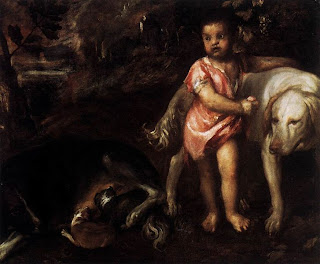 |
| Venus of Urbino, 1538, photo courtesy of WCC |
The
Venetian artist Titian attained great fame in his day through born talent for
observing and painting realistically the natural world. The painter’s exact birth year eludes
art historians to this day, due to his own desire to create a mystery about himself. He created this confusion for future
generations by drastically changing his age in many paintings. However, through ardent research,
historians placed his birth year at somewhere between 1487-90, and the year of
his death (something that artist could not befuddle) at 1576.
Vasari’s
biography of Titian, the last in The Lives of Artists, describes him as a man with so much natural talent
that had he been given rigorous stylistic schooling, he could have reached the
heights of Michelangelo, Leonardo or Raphael.
 |
| Danae Receiving the Golden Rain, 1553, photo courtesy of WCC |
Titian
began his studies with Giovanni Bellini, a prominent Venetian painter in his
day, and learned the style of Venice at the time. According to Vasari, in the year 1507, Titian discovered the
new technique adopted by Giorgione of Castlefranco and began to emulate
it. Giorgione painted with softer
lines and colors; and throughout his career, Titian became known for this
chiarascuric style of painting.
His paintings were often mistaken for those of Giovanni.
Throughout
the beginning of his career, it seems Titian was commissioned many times to
finish paintings and portraits by Bellini, who had weakened with age. He arose to prominence during this
time, and received many commissions of both religious paintings and portraits –
for which he is best known. Titian
painted many nudes, women who are so ethereal that even Michaelangelo noted
(according to Vasari) that “If Titian…had been assisted by art and design as
greatly as he had been by Nature…no artist could achieve more or paint better,
for he possesse[d] a splendid spirit and a most charming lively style”.
 |
| Boy with Dogs in a Landscape, 1576, photo courtesy of WCC |
In
his later career, Titian’s style shifted from his meticulous detailed works to
broad and bold brush strokes; and though they seem to be effortless, Vasari
writes that “his paintings [we]re reworked and that he ha[d] gone back over
them with colors many times, making his effort evident”. Toward the end of his life, the
biography states that Vasari visited the aging artist, who still had brushes in
his hands.
No comments:
Post a Comment